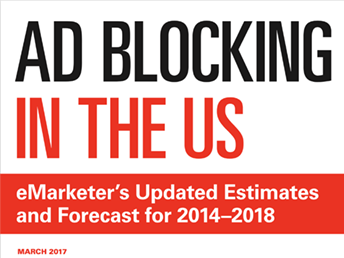30% of all Internet users will ad block by 2018

eMarketer
Ad blocking has grown far beyond a mere niche phenomenon into standard practice for many savvy Internet users.
eMarketer, the leading research firm for marketing in a digital world, estimates that about 25% of U.S. Internet users were employing ad blockers as of the end of 2016. But the practice remains skewed toward desktop/laptop computers and is less common on smartphones.
In an earlier media era, ad blocking consisted of going off to the bathroom when commercials came onto the TV screen. In the digital era, it is a bit more complicated: Consumers deploy technological means of blocking ads, while advertisers and publishers try to block the blockers.
This growing usage of ad blockers is leading to new challenges for anyone who needs to get their product in front of the eyeballs of readers and viewers.
eMarketer has put together the leading report on ad blocking that analyzes data from the company's latest estimates and forecast on ad blocking in the U.S. It shows that the practice is much more common via desktops/laptops than smartphones, and that it is concentrated among younger internet users.
Here are some key takeaways from the report:
The percentage of people using ad blockers is growing at a significant rate, though blocking established much of its presence earlier in the decade. eMarketer expects three in 10 internet users will be using blockers by the end of 2018.
Desktops/laptops—rather than smartphones—are the main venue for ad blocking. The proportion of desktop/laptop internet users who deploy blockers is more than twice as large as the proportion of smartphone users who do so. (However, as noted below, our definition of ad blocking excludes some smartphone actions that can have the effect of screening out ads a user might otherwise receive, even though this does not fall into the technical category of ad blocking.)
Unsurprisingly, younger people are more likely than their elders to use ad blockers. But the younger also conduct much of their digital activity on smartphones (where ad blocking is less feasible), which likely limits the amount of blocking that occurs in their typical digital day.
Ad blocking is still in a volatile stage, and it is possible that some sudden advance in technology could greatly alter the rate of blocker adoption by consumers.
The report also contains eight detailed charts that break down eMarketer's updated ad blocking forecast, quantify the population of ad blocking users, analyze the devices on which ad blocking is most prevalent, and points out some demographic wrinkles.
Here's how you get this exclusive ad blocking research:
To provide you with this exclusive report, eMarketer has partnered with BI Intelligence, Business Insider's premium research service. This report is not available for individual sale anywhere else, and we're bringing it to you at a deep discount!
eMarketer's Ad Blocking in the U.S. Report is the ONLY resource you need to answer all of your questions. Click here to purchase this exclusive report.
See Also:

 Yahoo News
Yahoo News 
